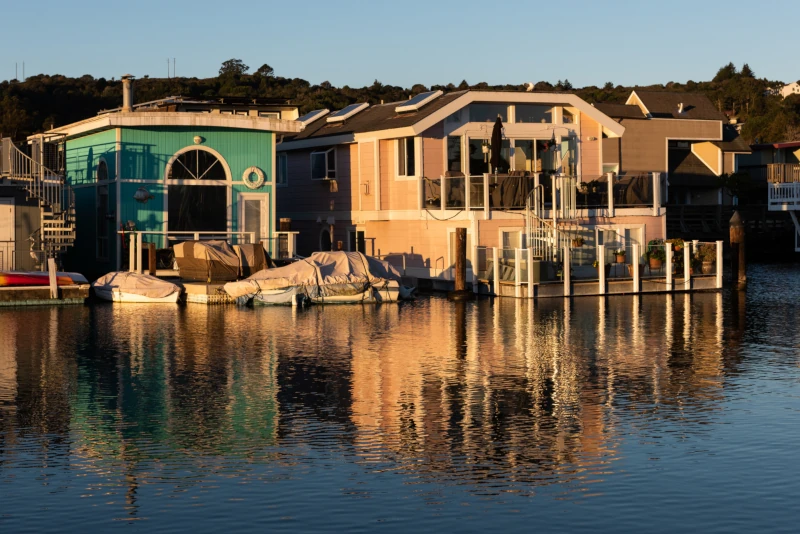A recent article in The New York Times for dealing with rising sea levels: building homes on the water. Marin County is no stranger to that concept. An entire community exists in Sausalito. In fact, there are approximately 425 floating homes in Marin County, according to Marin County Residential Real Estate. Sausalito boasts the largest corner on that market, with a fabled community of about 400 floating structures.
To those of us who’ve lived here for any length of time, we might be more familiar with the term houseboats.
Floating Home vs. Houseboat?
Floating homes are often quite luxurious, offering most of the amenities of their landlocked counterparts. They are also permanently moored in one place with no options for self-propulsion. A houseboat, on the other hand, is smaller and is capable of maneuvering on its own from one mooring to another.
Floating homes, because they are stationary, can have utilities delivered through the grid, or they can use solar power or a combination of the two.
The idea of moving to a home on the water might feel radical to some and delightful to others. In specific countries it might feel like a wise option. Take the Netherlands, for instance. With building new homes, offices and even farms on the water makes sense.
While floating homes seem perfect for our mild Mediterranean climate in the Bay Area, countries that experience high windstorms, hurricanes and frequent flooding lack stability that could spell disaster for a floating home.
Even Marin County is not immune to bizarre weather. In an article on oursausalito.com, the iconic Taj Mahal houseboat in moored in the Sausalito Yacht Harbor (accurate) and as a floating home (inaccurate). The vessel received heavy damage in the “bomb cyclone” rain and windstorm of March 21, 2023. It sank. A recovery effort raised the houseboat, but its fate is still unclear.
Can sea level rise spur floating communities?
Since approximately three billion people or about half of the world’s population, live within 125 miles of a coastline, there is pressure to consider the threats of sea-level rise and solutions to adapt. There are many things to consider with the development of floating communities. Besides weather conditions, the development and maintenance of a self-sufficient ecosystem capable of producing energy, food and water is key. The long-term effects of a large floating city on a shoreline are essential to consider.
While the concept of floating cities goes back centuries, social acceptance of new floating cities is not a given. Most would be integrated into existing urban areas to be successful. That would entail, at a minimum, extensive revamping of current zoning laws and building codes. However, as climate change marches on and the sea rises, public entities may be more open to exploring the opportunities.
Due to the necessity for unique logistic and engineering strategies, the construction and maintenance of the infrastructure required to support a floating city need definition. But just as travel to the moon seemed impossible at one point, human nature rises to new challenges with innovative solutions. The solutions needed to explore the possibility of expanding the creation of floating homes, cities and even farms are already underway.
As the seas continue to rise, will we rise to the occasion?
If you want to see a thriving community on the water, visit the one dubbed “The Venice of the West” in Waldo Point Harbor, Sausalito. You might be surprised at what you find.


